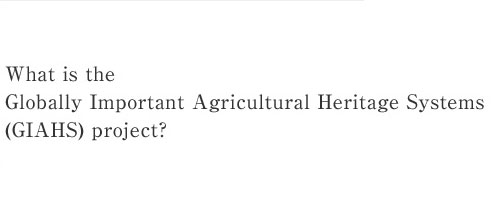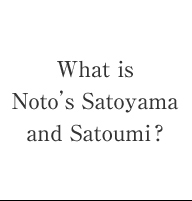|
HOME > What is Noto's Satoyama and Satoumi? > What is GIAHS?  
GIAHS was founded against a background of an overemphasis on productivity by modern agriculture that resulted in environmental problems such deforestation and water pollution throughout the globe, causing destruction of unique local cultures, landscapes and biodiversity. The overall goal of the project is to identify and safeguard, from the bad effects of modernization, Globally Important Agricultural Heritage Systems and their associated landscapes, traditional agriculture, agricultural systems and agricultural diversity, and knowledge systems and land use through dynamic conservation in order to pass them on to future generations. While the United Nations Educational, Scientific and Cultural Organization (UNESCO) aims to designate and protect real estates such as historic monuments and buildings and natural areas, the purpose of GIAHS is to seek maintenance and conservation of agricultural systems to pass them to future generations, through the granting of special designation. 11 sites have been designated in Japan: Noto's satoyama and Satoumi (Noto peninsula, Ishikawa prefecture, June 2011), Sado's satoyama in Harmony with Crested Ibis (Sado city, Niigata prefecture, June 2011), Traditional tea-grass integrated system in Shizuoka(Local name:Chagusaba) (Shizuoka prefecture, May 2013), Managing Aso Grasslands for Sustainable Agriculture (Kumamoto prefecture, May 2013), Kunisaki Peninsula Usa IntegratedForestry, Agriculture and Fisheries System (Oita prefecture, May 2013),Ayu of the Nagara River System(Gifu prefecture, Dec 2015),Minabe-Tanabe Ume System(Wakayama prefecture, Dec 2015),Takachihogo-Shiibayama Mountainous Agriculture and Forestry System(Miyazaki prefecture, Dec 2015),Osaki Kodo's traditional water management system for sustainable paddy agriculture(Miyagi prefecture, Nov 2017),Traditional WASABI cultivation in Shizuoka(Shizuoka prefecture, Mar 2018),Nishi-Awa Steep Slope Land Agriculture System(Tokushima prefecture, Mar 2018) reference : Food and Agriculture Organization of the United Nations reference : Ministry of Agriculture, Forestry and Fisheries of JAPAN
|
 |
     Loading
|





























GIAHS is a project that was started in 2002 by Food and Agriculture Organization (FAO, based in Rome, Italy), the United Nations agency that aims to ensure food security for all.